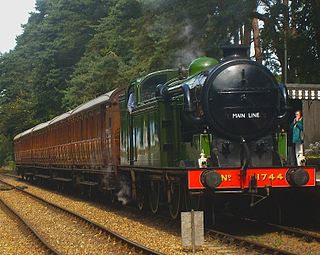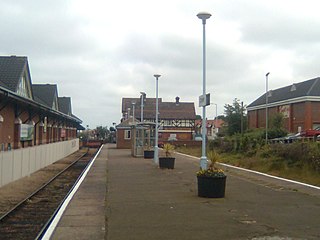
The North Norfolk Railway (NNR) – also known as the "Poppy Line" – is a 5+1⁄4-mile (8.4 km) heritage steam railway in Norfolk, England, running between the towns of Sheringham and Holt. The North Norfolk Railway is owned and operated as a public limited company, originally called Central Norfolk Enterprises Limited. The railway is listed as exempt from the UK Railways (Interoperability) Regulations 2000.

Sheringham is a seaside town and civil parish in the county of Norfolk, England. The motto of the town, granted in 1953 to the Sheringham Urban District Council, is Mare Ditat Pinusque Decorat, Latin for "The sea enriches and the pine adorns".

Sheringham Park is a landscape park and gardens near the town of Sheringham, Norfolk, England. The park surrounds Sheringham Hall, lying mostly to its south. The hall is privately occupied, but Sheringham Park is in the care of the National Trust and open to visitors.

Holt is a market town, civil parish and electoral ward in the English county of Norfolk. The town is 22.8 miles (36.7 km) north of the city of Norwich, 9.5 miles (15.3 km) west of Cromer and 35 miles (56 km) east of King's Lynn. The town has a population of 3,550, rising and including the ward to 3,810 at the 2011 census. Holt is within the area covered by North Norfolk District Council. Holt has a heritage railway station; it is the south-western terminus of the preserved North Norfolk Railway, known as the Poppy Line.

Melton Constable is a village and civil parish in the English county of Norfolk. It covers an area of 6.96 km2 (2.69 sq mi) and had a population of 518 in 225 households at the 2001 census. The population had increased to 618 at the 2011 Census. For the purposes of local government, it falls within the district of North Norfolk. The village sits on fairly high ground south-west of Holt.

The Midland and Great Northern Joint Railway (M&GNJR) was a railway network in England, in the area connecting southern Lincolnshire, the Isle of Ely and north Norfolk. It developed from several local independent concerns and was incorporated in 1893. It was jointly owned by the Midland Railway and the Great Northern Railway, and those companies had long sponsored and operated the predecessor companies.

The Bittern Line is a railway branch line in Norfolk, England, that links Norwich to Sheringham. It passes through the Broads on its route to an Area of Outstanding Natural Beauty on the north Norfolk coast. It is named after the bittern, a rare bird found in the reedy wetlands of Norfolk.

Sheringham railway station is the northern terminus of the Bittern Line in Norfolk, England, serving the town of Sheringham. It is 30 miles 22 chains down the line from Norwich. Its three-letter station code is SHM.

The A149 is commonly known as "The Coast Road" to local residents and tourists, as this road runs along the North Norfolk coast from King's Lynn to Great Yarmouth, via coastal villages.

Cromer High railway station was the first station opened in Cromer, Norfolk, in England. It is situated to the south on the outskirts of the town on a steep escarpment. Built initially by the short-lived East Norfolk Railway, the station was incorporated into the Great Eastern Railway, who had operated the services from the beginning. It served as the terminus of Great Eastern Railway services from London and Norwich. Initially named Cromer on opening, it was renamed Cromer High on 27 September 1948.
High Kelling is a village and civil parish in the north of the English county of Norfolk. The village is located on the A148 road which links Cromer to King's Lynn. The village is 1.7 miles east of the town of Holt, and 7.8 miles west of Cromer. High Kelling is within the area covered by North Norfolk District Council. In the last Census, carried out in 2001, the population of High Kelling was counted as 515, increasing to 636 at the 2011 census.

The Norfolk Orbital Railway – as the Holt, Melton Constable and Fakenham Railway Company – is a proposed rail project in Norfolk, England, which is proposed to look at bringing a new rail connection to North and Mid Norfolk.

Cromer is a railway station in the English county of Norfolk. Because the Midland and Great Northern Joint Railway (M&GNJR) line approached Cromer from the west, following the coastal clifftops, it avoided the steep escarpment which had prevented the earlier line from Norwich running all the way into the town. Consequently, it became possible to build a far more conveniently located station, near to the town centre and the beach. The station opened as Cromer Beach on 16 June 1887 and was renamed Cromer on 20 October 1969, following the closure of Cromer High station in 1954. It is 26 miles 52 chains (42.9 km) down the line from Norwich. Cromer is one of only two former Midland and Great Northern Joint Railway stations to remain operational on the National Rail network; the other being the neighbouring West Runton. Sheringham and Weybourne are the other two surviving M&GNJR stations; both are still served today on the heritage North Norfolk Railway.

Melton Constable was a railway station on the Midland and Great Northern Railway which served the North Norfolk village of Melton Constable from 1882 to 1964. Notwithstanding its rural location, the station became an important railway centre with lines converging from all directions providing connections to key East Anglian towns such as King's Lynn, Norwich, Cromer, Fakenham, Yarmouth and Lowestoft. Although long since demolished, there is a possibility that the station may yet be resurrected as part of the proposed Norfolk Orbital Railway.

Sheringham is the name of a preserved railway station in Sheringham, Norfolk. It was once part of the Midland and Great Northern Joint Railway network and closed in 1967 when a new station was opened by British Rail approx. 200m eastwards. Since 1975 it has served as the eastern terminus of the North Norfolk Railway. In March 2010, the link to Network Rail was reinstated.

Weybourne railway station is a station in Weybourne, Norfolk, on the preserved North Norfolk Railway. Sometimes referred to as “Webbun”, it was formerly part of the Midland and Great Northern Joint Railway route between Melton Constable and Cromer. Regarded as an iconic Edwardian masterpiece. The station is open whenever trains are in operation, and holds various themed events throughout the year.

Railways have played an important part in the history and development of the English county of Norfolk. It currently has thirty open National Rail stations, though there were once well over a hundred.
The Cromer line was a railway branch in Norfolk, England that connected the railway junction of Melton Constable with Cromer on the sea.

The East Norfolk Railway was a pre-grouping railway company operating a standard gauge 25 mile, mostly single track, railway running between Norwich Thorpe railway station and Cromer in the English county of Norfolk. It opened in 1874, reaching Cromer three years later, and remains mostly operational. The company also operated a branch between Wroxham and County School, which closed to passengers in 1952, and had proposed a branch to Blakeney in 1878, which was never constructed.

Melton Constable railway works was a railway maintenance and production facility on the Midland and Great Northern Railway. The buildings and operations in the village of Melton Constable from 1883 to 1964 were vital to the village economy and indeed it is known that the village itself was created to house the employees who worked there. The works are known by many as the 'Crewe of North Norfolk' as Crewe was similar to Melton Constable, although on a much larger scale. Since the loss of the works and rail links the village has never recovered to pre World War I levels.


















